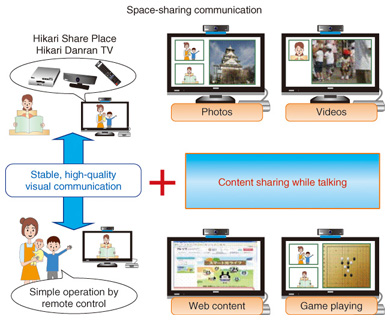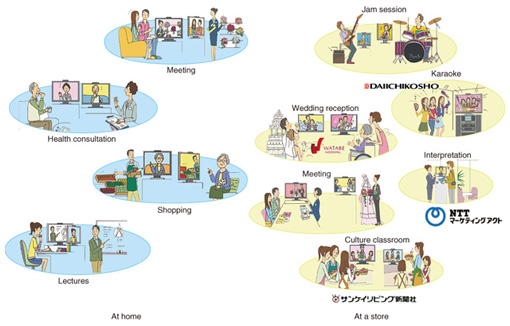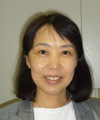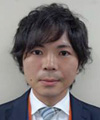 |
|||||||||||
|
|
|||||||||||
|
Feature Articles: Developments of the Visual Communication “Hikari Living” Project Vol. 12, No. 2, pp. 32–36, Feb. 2014. https://doi.org/10.53829/ntr201402fa7 Space-sharing Communication by Hikari Share Place and Hikari Danran TV and Future Business DevelopmentAbstractDecember 2012 marked the launch of Hikari Share Place (NTT EAST) and Hikari Danran TV (NTT WEST) as two products that enable high-quality, real-time visual communication using a home television (TV). These products were enhanced in August 2013 with a content sharing during calls function that allows the sharing of data such as photos and videos and the sharing of web content while the user is conversing with another party. With the addition of this function, Hikari Share Place and Hikari Danran TV will help make space-sharing communication a reality among family members, friends, and acquaintances living far apart from each other. New ways of using these products can also be expected through alliances with other operators. Keywords: space sharing, visual communication, content sharing 1. IntroductionRecent years have seen a rapid increase in the number of households consisting of elderly persons living by themselves in addition to those made up of nuclear families and individuals living away from home for work. Against this background, NTT EAST and NTT WEST sought a means by which people with close ties but living apart from each other could use the television (TV) in their living rooms to easily create a shared space for relaxation and communication at any time, thereby overcoming the limitations of time and distance. To this end, they developed Hikari Share Place (NTT EAST) and Hikari Danran TV (NTT WEST)*1 in collaboration with NTT laboratories and launched these products in December 2012 [1]–[3].
2. Service overviewThis service constitutes an information device that enables high-quality visual communication and content sharing during calls by connecting the product to a home TV supporting the HDMI (High-Definition Multimedia Interface) and using that TV’s screen (Fig. 1). Because the other party’s surroundings can be shown on the TV’s large screen, this service goes beyond the face-centered communication of past systems by sharing the atmosphere of the other party’s location in such a way that the user feels as if he or she is also there. This capability makes for enjoyable visual communication.
3. Main features3.1 Communication by stable, high-quality video and clear audioVisual communication provided by this service makes uses of NTT’s HIKARI DENWA optical fiber IP (Internet protocol) telephony service, which, in turn, uses the Next Generation Network (NGN) developed by the NTT Group. In contrast to best-effort type videophones that use the Internet, this service enables extremely stable visual communication through connections that secure sufficient bandwidth. The high-definition quality video and clear audio provided by this service will enable users to enjoy space-sharing communication with a high sense of presence. The product is equipped with echo cancellation technology incorporating noise suppression, which was developed by NTT Media Intelligence Laboratories to enable stress-free and enjoyable video calls using one’s own TV in one’s own living space. 3.2 Sharing diverse content while talking with the other partyWe can all imagine a scene in which a family reminisces about the past while viewing photographs of a family outing or a video of a sports day at school. This service has made such activity possible even for family members living far apart by providing a content-sharing function that can be used even while a call is in progress. This content sharing during calls function incorporates the content-sharing technology of NTT Service Evolution Laboratories that enables the bidirectional transmission of data while users talk, based on NGN SIP (session initiation protocol). As a result, users can share and save various types of content including photos, videos, and website URLs while a video or audio call is in progress. With this technology, a user sends content to the other party by bandwidth-guaranteed data communication (data connect) over HIKARI DENWA, thereby enabling stable and secure transmission of content to another party with operations as simple as making a call. 3.3 Simple setup and operation and reasonable usage feeAll devices and cables necessary to use this service—including the main unit, remote control, and microphone/camera—are bundled with the product. As a result, all the user needs to do to start using the service immediately is to unpack and connect those components (Fig. 2). The service is designed with a user interface and screen transitions that even users who are apt to say “I don’t know how to proceed!” or “I can’t operate this!” will find straightforward and easy to understand.
Furthermore, to make the service easy to operate even for small children and the elderly, the service incorporates features that enhance the usability of both hardware and software components. For example, the functions that can be used with this service are listed on the home screen when the device starts up so that the desired function can be selected in an intuitive manner. In addition, photos or videos received through the content-sharing function are displayed as thumbnails at the bottom of the home screen that can act as a stimulus to conversation with the other party. NTT EAST and NTT WEST also provide a flat-rate plan for this service called Terebidenwa Choisu Teigaku (Videophone Choice Flat Rate)*2 so that users can enjoy talking as much as they like without worry. The Videophone Choice Flat Rate plan is a service that allows video calling to a previously designated telephone number at a flat rate. In the NTT EAST area, the customer may designate up to two telephone numbers and make as many video calls to each number as desired at a flat rate under the condition that each call is less than 30 minutes. In the NTT WEST area, the number of telephone numbers that can be designated and the maximum calling time per call under the flat-rate plan have been extended to five numbers and three hours, respectively, to make it easy to use the service under a variety of usage scenarios. The fee for Videophone Choice Flat Rate is 525 yen (tax included) per month at both NTT EAST and NTT WEST. NTT WEST also provides all necessary equipment under a rental plan to reduce the customer’s initial expenses for this service.
4. Future business developmentUnder the basic concept of space-sharing communication with cherished family members or people we hold dear living far away, we can envision a variety of usage scenarios for this service including daily use. The service could be used, for example, to hold events such as birthday parties, to share dinner with a father living away from home for work—just as if the whole family were gathered around their dining table, and to check on the condition of one’s elderly mother who lives by herself. Furthermore, in the area of visual communication, this service is applicable to a variety of fields including education, caregiving and medical care, commerce, and entertainment. The plan is to develop this service through alliances with other business operators. Some current examples include Watabe Wedding, a wedding service company using visual communication to provide a service called Tsunagaru (Connect) Wedding—Hello Celebration that enables relatives and friends who cannot attend the customer’s wedding to participate remotely in the wedding reception, and Sankei Living Shimbun Inc., which is currently experimenting with a culture classroom service that connects its main venue with satellite venues via a video link. We are also holding joint studies on service creation with many other operators. Our goal here is to form alliances that will facilitate the use of visual communication in a wide range of everyday applications. These could be home schooling to receive lessons from school or cram school while at home, or simply remote personal instruction; shopping support for individuals who have trouble getting out for physical reasons; exercise lessons for the elderly living in sparsely populated areas to improve their health; and a department store concierge service in which users can receive general advice from staff on clothes coordination and dressing (Fig. 3).
Going forward, NTT EAST and NTT WEST seek to spread the use of space-sharing communication via the service introduced here by creating a variety of usage scenarios that can add convenience and pleasure to everyday life. References
|
|||||||||||
















